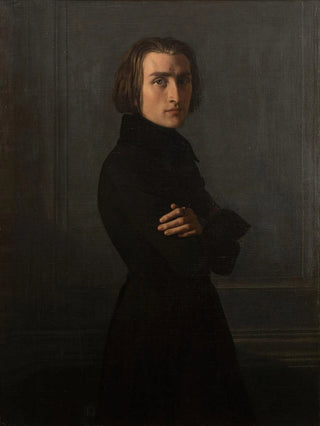Art print | Portrait of Franz Liszt 1811-1886, composer and pianist - Henri Lehmann


View from behind

Frame (optional)
Reproduction Portrait of Franz Liszt 1811-1886, composer and pianist - Henri Lehmann – Captivating introduction
The portrait of Franz Liszt, created by Henri Lehmann, is a work that captures the very essence of musical passion and virtuosity. This painting, beyond its simple representation, evokes the depth of a character who has left a mark on the history of Romantic music. Liszt, an iconic composer and pianist of the 19th century, is depicted here in all his splendor, revealing not only his appearance but also the intensity of his creative genius. Through this portrait, Lehmann offers us a window into the artist's soul, inviting us to explore the emotions and thoughts that animated him. The light and shadow, rich colors, and meticulous details testify to an era where music and art intertwined intimately, creating an atmosphere that is both personal and majestic.
Style and uniqueness of the work
Lehmann's style is distinguished by his ability to capture the personality of his subjects with remarkable finesse. In this portrait, he uses a palette of warm colors that accentuate the liveliness of Liszt's face, while delicate shadows add an almost sculptural dimension to his figure. The composer’s expression, both focused and dreamy, reveals a fascinating duality: that of a man deeply engaged in his art while being prey to his inner reflections. The composition, well balanced, highlights Liszt's imposing stature while emphasizing his artistic sensitivity. Every brushstroke seems to vibrate to the rhythm of the music he loved so much, making this work a true ode to creativity.
The artist and his influence
Henri Lehmann, a 19th-century French artist, made a name for himself in the artistic world thanks to his exceptional talent and his ability to portray emblematic figures of his time. His training at the École des Beaux-Arts in Paris allowed him to acquire a technical mastery reflected throughout his oeuvre. By painting Liszt, Lehmann does not merely depict a musician; he immortalizes a key moment in the history of music. Liszt, through his innovations and his char

Matte finish

View from behind

Frame (optional)
Reproduction Portrait of Franz Liszt 1811-1886, composer and pianist - Henri Lehmann – Captivating introduction
The portrait of Franz Liszt, created by Henri Lehmann, is a work that captures the very essence of musical passion and virtuosity. This painting, beyond its simple representation, evokes the depth of a character who has left a mark on the history of Romantic music. Liszt, an iconic composer and pianist of the 19th century, is depicted here in all his splendor, revealing not only his appearance but also the intensity of his creative genius. Through this portrait, Lehmann offers us a window into the artist's soul, inviting us to explore the emotions and thoughts that animated him. The light and shadow, rich colors, and meticulous details testify to an era where music and art intertwined intimately, creating an atmosphere that is both personal and majestic.
Style and uniqueness of the work
Lehmann's style is distinguished by his ability to capture the personality of his subjects with remarkable finesse. In this portrait, he uses a palette of warm colors that accentuate the liveliness of Liszt's face, while delicate shadows add an almost sculptural dimension to his figure. The composer’s expression, both focused and dreamy, reveals a fascinating duality: that of a man deeply engaged in his art while being prey to his inner reflections. The composition, well balanced, highlights Liszt's imposing stature while emphasizing his artistic sensitivity. Every brushstroke seems to vibrate to the rhythm of the music he loved so much, making this work a true ode to creativity.
The artist and his influence
Henri Lehmann, a 19th-century French artist, made a name for himself in the artistic world thanks to his exceptional talent and his ability to portray emblematic figures of his time. His training at the École des Beaux-Arts in Paris allowed him to acquire a technical mastery reflected throughout his oeuvre. By painting Liszt, Lehmann does not merely depict a musician; he immortalizes a key moment in the history of music. Liszt, through his innovations and his char






